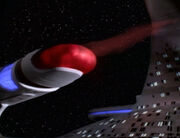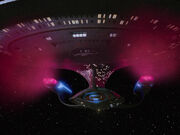(tibit on ARPrise) |
No edit summary |
||
| Line 1: | Line 1: | ||
| + | [[File:AR Enterprise Bussard collector.jpg|thumb|{{USS|Enterprise|alternate reality}} Bussard collector]] |
||
[[File:Sovereign bussard collector.jpg|thumb|{{Class|Sovereign}} ramscoop]] |
[[File:Sovereign bussard collector.jpg|thumb|{{Class|Sovereign}} ramscoop]] |
||
[[File:Bussard collector, 2367.jpg|thumb|{{Class|Galaxy}} Bussard collector]] |
[[File:Bussard collector, 2367.jpg|thumb|{{Class|Galaxy}} Bussard collector]] |
||
Revision as of 12:40, 24 August 2012
USS Enterprise Bussard collector

Sovereign-class ramscoop

Galaxy-class Bussard collector
The Bussard collector, also known as a Bussard ramscoop or ramscoop, was a device usually attached to the forward end of a warp nacelle.
All Federation starships were equipped with Bussard collectors, which were positioned in the best line of sight to collect interstellar particles. Collection worked best in regions where particle density was high, such as in solar systems or nebulae.
The Bussard collector normally collected hydrogen, especially deuterium, for fuel replenishment, but could be reconfigured to collect various gases like sirillium and plasma particles.
In 2374, Seven of Nine determined that the collectors of an Intrepid-class starship were less than optimal. She performed a series of modifications that enhanced them by twenty-three percent. (VOY: "Unforgettable")
A Bussard collector could also be reconfigured to expel gases or plasma. (TNG: "Samaritan Snare") Bussard collectors were not capable of producing nadion emissions. (VOY: "The Haunting of Deck Twelve") The Tosk variation of the Bussard collector was known as the arva node. (DS9: "Captive Pursuit")

Bussard collectors expelling gases
In 2365, the USS Enterprise-D's collectors were used to create a harmless pyrotechnic display against the Pakleds to recover Lieutenant Geordi La Forge by igniting released hydrogen. This event came to be known as a crimson force field. (TNG: "Samaritan Snare")
In 2367, the Enterprise-D released large quantities of hydrogen from its Bussard collectors to create a violent explosion. (TNG: "Night Terrors")
In 2373, USS Voyager's collectors were used to gather the sirillium from a class 17 nebula. It was described that they would "cut through that nebula like ice cream scoops." (VOY: "Flashback") They were modified to gather plasma particles from an astral eddy. (VOY: "Real Life")
In 2375, Commander William T. Riker used the USS Enterprise-E's collectors to gather, and then vent, metreon gas against attacking Son'a vessels, a maneuver which Commander La Forge nicknamed the Riker Maneuver. (Star Trek: Insurrection)
In 2376, USS Voyager's collectors were modified to gather deuterium from a J class nebula. (VOY: "Unforgettable", "The Haunting of Deck Twelve")
